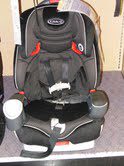As parents of multiples, it stands to reason that we will need several car seats. Many of us have other children as well, so car seats can be a huge issue.
The following has been put together to give you some hints to consider before you either purchase or borrow any used car seats in attempt to cut expenses. If you are in any doubt about the used car seat you are purchasing or borrowing, don’t do it. After all, your most precious cargo will be using these seats and they are depending upon you to help keep them safe.
NOTE: This information is provided as a set of guidelines. If you have any doubt about any used car seat, check with Transport Canada (contact information below) or the car seat’s manufacturer.
 Car seats have carried a manufacturer’s date for some years now. The date is usually stamped on the manufacturer’s label on the back of each car seat. Make sure each car seat is not more than 10 years old. Our Canadian extreme temperatures, over time, break down the plastic in seats and, depending upon how old they are, they may not be as safe as when they were manufactured.
Car seats have carried a manufacturer’s date for some years now. The date is usually stamped on the manufacturer’s label on the back of each car seat. Make sure each car seat is not more than 10 years old. Our Canadian extreme temperatures, over time, break down the plastic in seats and, depending upon how old they are, they may not be as safe as when they were manufactured.- If a used car seat is 8, 9 or 10 years old, you may wish to pass onit as multiple birth children tend to use their equipment somewhat longer than a singleton child. In these cases, the ‘best by’ date is nearly past and you may not wish to have to repurchase newer seats at a later date, thereby doubling your expenses.
- Each seat should have its manufacturer’s instructions showing how to install the seat into a car and how to correctly place a child into that seat. No instructions, then pass it by! If you are purchasing a new car seat, keep the instructions to go along with the car seat when/if you pass it along yourself.
- Assess the interior of each seat. Are any of the straps worn, buckles missing? If yes, pass on the seat. Is the interior pad torn? If yes, consider the cleanliness of the car seat. Hygiene within a car seat, as well as safety, can be an issue.
- Check the tether strap for forward-facing car seats, i.e. the strap that anchors the seat to the car frame. It needs to be in good condition.
- Make sure you know if the used car seat has been in a car crash whether or not there was a child in the seat at the time of the crash.Even in the case of a minor accident, there could be stress fractures to the seat. If you can’t determine an accurate history for the seat, don’t risk using it.
- If you have a car seat that has been involved in a car crash, even without a child in it, it is now deemed unsafe. Make sure that it is safely destroyed. Don’t risk putting it out at the curbside in case someone else picks it up to use. By the same token, NEVER pick up a car seat from someone else’s curbside.
- Do notpurchase a new or used car seat manufactured in the United States. American seats do not meet Canadian safety standards.
- Make sure to read Multiple Birth Canada’s Fact Sheet “Car Seat Tips” for other important information regarding car seats and your children. Learn how to assess when each child is ready to graduate to the next size car seat. Remember that each child may not be ready to graduate to the next size car seat at the same time.
FOR FURTHER INFORMATION ON CAR SEATS, contact Transport Canada at 1-800-333-0371 or visit their Website at www.tc.gc.ca/roadsafety/childsafe/notiavis/en/index.htm
